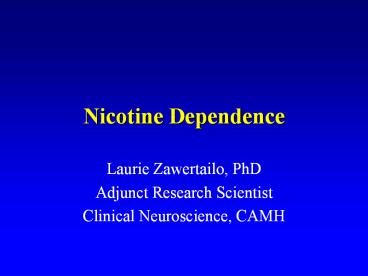Nicotine Dependence - PowerPoint PPT Presentation
Title:
Nicotine Dependence
Description:
To review the main physiological and pharmacological ... Buccal and nasal mucosa, skin, GI tract. Blood flow, membrane permeability, surface area, and pH ... – PowerPoint PPT presentation
Number of Views:90
Avg rating:3.0/5.0
Title: Nicotine Dependence
1
Nicotine Dependence
- Laurie Zawertailo, PhD
- Adjunct Research Scientist
- Clinical Neuroscience, CAMH
2
Objectives
- To review the main physiological and
pharmacological aspects of nicotine use, abuse,
and dependence. - To discuss the different treatments available for
nicotine dependence.
3
Cigarette Smoking (Statistics)
- 47 worldwide
- 47 men
- 12 women
- 25 North America
- 1/3 - 1/2 of adolescents daily smoking
- 15 - 25 success rate to quit smoking
- Spontaneous quit rates in adults 6-7
4
Costs of Tobacco Dependence
- 30 (males) and 17 (females) of all cancer
deaths in Canada are due to smoking. - Over 25 of cancer burden in Canada is
attributable to lung cancer. - 80 - 90 of lung cancers are directly
attributable to smoking - Smoking is also directly linked to
- Diabetes
- Heart disease
- Stroke
- Respiratory diseases
- CV disease
5
Factors Associated With Smoking
- Biological
- hereditary, psychiatric, psychological
- Environmental
- parties, bars
- Social predisposition
- family, friends, cultural
- Easy access
- Socially acceptable?
- Peer pressure
6
Factors
ENVIRONMENT
VECTOR
HOST
AGENT
7
- Release of catecholamines increasing sympathetic
tone (GI motility, cardiac stimulation),
arginine-vasopressin, beta endorphins, ACTH,
cortisol, GH, PL, etc. - Enhanced memory, task performance, concentration,
attention, and anxiety reduction.
?
8
- Clinical conditions associated with smoking
- Respiratory
- Cardiovascular
- Comorbidity
- Psychiatric disorders
- Schizophrenia, depression, anxiety
- Other drugs of abuse
- Alcohol abuse/dependence
9
Nicotine
- Psychoactive drug contained in tobacco
- Likely responsible for the addictive properties
of cigarettes - Self-administered by animals and humans
- Reinforcing and rewarding
- Following continuous administration the
reinforcing effects of nicotine become prominent
and the control over its use is lost
10
- Nicotine content in cigarettes
- 6 11 mg (1-3 mg are absorbed)
- Pack a day 20 40mg
- Smokers adjust their nicotine intake
- High yield nicotine less cigarettes
- Low yield nicotine more cigarettes
11
Pharmacology of Nicotine
- Absorption
- Buccal and nasal mucosa, skin, GI tract
- Blood flow, membrane permeability, surface area,
and pH - Other factors known to modify the rate of
absorption - Degree and depth of inhalation
- Number, duration, and volume of puffs
- Use of a filter
- Number of cigarettes smoked
- Time spent smoking each cigarette
12
Peak nicotine concentrations are reached after
completion of cigarette smoking
- Distribution
- 19 seconds to reach the brain
- Half-life 2 hours
- Metabolism and elimination
- Liver and kidneys
- Main metabolite cotinine (70 - 80)
- CYP 2A6
13
Pharmacokinetics of Nicotine After Smoking
14
Neuropharmacology of Nicotine Dependence
- nAChRs
- Dopaminergic system (reward)
- Tolerance, physical dependence
- MAO A and B
15
Cigarette
Smoking initiation
Nicotine
Reward Pathological learning
Smoking continuation
Active nAChRs
Dopamine release
Desensitized nAChRs
Acute tolerance
Inactive nAChRs
Chronic tolerance
Perpetuation of smoking behaviour
Smoking discontinuation
Hyper excitable nAChRs
Withdrawal
Increased no. of AChRs
Smoking relapse
Drive for the next cigarette
16
Tobacco as a Drug of Abuse
DRUG ever used addiction risk
Tobacco 75.6 24.1 31.9
Alcohol 91.5 14.1 15.4
Illicit Drugs 51.0 7.5 14.7
Cannabis 46.3 4.2 9.1
Cocaine 16.2 2.7 16.7
Anxiolytics 12.7 1.2 9.2
Analgesics 9.7 0.7 7.5
Psychedelic 10.6 0.5 4.9
Heroin 1.5 0.4 23.1
Goodman and Gilman, 2001
17
Nicotine Withdrawal Syndrome
- ? Psychological
- Irritability
- Anxiety
- Aggressiveness
- Inability to concentrate
- Depressed mood
- ? Physical
- Difficulty sleeping
- Increased appetite
- Headache
18
Drug (Nicotine) Dependence DSM IV Criteria
- Inability to stop using the drug
- Preoccupation about drug use
- Use despite harmful consequences
- Presence of symptoms accounting for brain
adaptation resulting in persistence use of the
drug - Use despite significant drug-related problems
19
Fagerström Test for Nicotine Dependence
20
(No Transcript)
21
Treatments for Nicotine Dependence
- Behavioural Intervention Therapies
- Individual behavioural counseling
- Nicotine fading
- Aversion treatments
- Acupuncture
- Hypnosis
22
- Nicotine Replacement Therapies
- Patch (7, 14, 21, 22mg) 6-12 wks
- Gum (2 and 4mg) 8-12 wks
- Inhaler (4mg/cartridge) 6 16/day 3-6 mo
- Nasal spray (1-2/hr 0.5mg each max 40mg/day)
3-6mo - Low yield cigarettes
23
- Bupropion
- 150mg twice/day 8-12 wks
- Risk of seizures (gt300mg)
- Nortriptyline
- Clonidine
- Nicotine Blockade Therapy
- Mecamylamine
- Experimental approaches
- GABA agonists (vigabatrin)
24
Factors Associated With Low Quitting Success Rate
- Comorbid psychiatric conditions
- Alcohol or substance abuse
- High nicotine dependence
- Lack of social support for quitting
- Low self-confidence in ability to quit
25
Pharmacokinetics of NRT
26
Treating Tobacco Dependence
- Smoking is a complex human behaviour
- Often takes several quit attempts before one is
successful - NRT is most successful when combined with
supportive care. - Lapse and relapse is very common.































